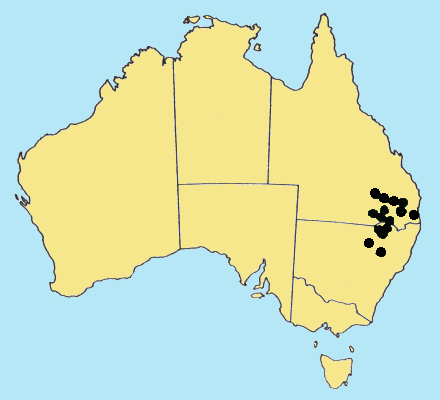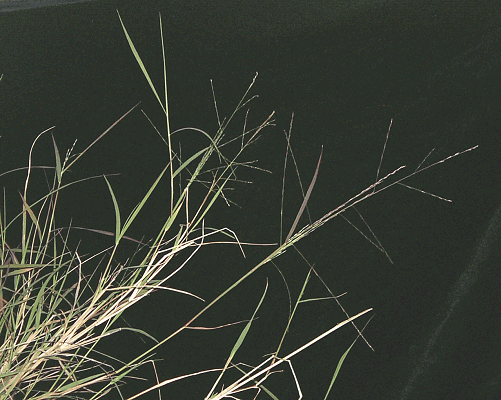Dinebra divaricatissima (S. T.
Blake) P.M.Peterson & N.Snow, Phytoneuron 2012-71: 1-2 (2012)
Classification. (GPWG 2001) : Subfamily Chloridoideae. Cynodonteae.
Type of Basionym or
Protologue Information: HT: S.T. Blake 10517, Australia:
Queensland:
Goondiwindi (BRI-131665–6; IT: CANB, K, MO, NSW, PRE).
Recent Synonyms: Leptochloa divaricatissima
Key references
(books and floras): [2002] D.Sharp & B.K.Simon, AusGrass, Grasses of
Australia as Leptochloa,
[2008] S.W.L.Jacobs, R.D.B.Walley & D.J.B.Wheeler, Grasses of New South
Wales (294) as Leptochloa.
Illustrations:
[2008] S.W.L.Jacobs, R.D.B.Whalley & D.J.B.Wheeler, Grasses of New South
Wales, 4th edn (294).
Habit.
Perennial. Culms stature slender to delicate, 20–60 cm tall. Mid-culm
internodes glabrous or pubescent. Lateral branches simple or sparsely branched.
Leaf-sheaths glabrous on surface or hairy. Ligule an eciliate membrane, 1–2 mm
long, lacerate. Leaf-blades 3–24 cm long, 1.5–4 mm wide. Leaf-blade surface
scabrous, glabrous.
Inflorescence.
Inflorescence compound, a panicle of racemes. Racemes numerous, 20–30,
spreading or deflexed, 6.5–20 cm long. Central inflorescence axis 15–60 cm
long.
Spikelets.
Spikelets pedicelled. Fertile spikelets many flowered, with at least 2 fertile
florets (3–5), comprising 3–5 fertile floret(s), with diminished florets at the
apex, oblong, laterally compressed, 3–4 mm long.
Glumes. Lower
glume ovate, membranous, keeled, 1-keeled, 1 -nerved. Upper glume oblong or
ovate, 1.5–2.8 mm long, membranous, keeled, 1-keeled, 1 -nerved. Upper glume
apex muticous or mucronate.
Florets.
Fertile lemma 2–2.4 mm long, keeled, 3 -nerved. Lemma surface indumented. Lemma
apex muticous or mucronate. Palea 2 -nerved. Grain 0.9–1.1 mm long.
Continental
Distribution: Australasia.
Australian
Distribution: Queensland, New South Wales.
Queensland:
Leichhardt, Darling Downs, Moreton, Maranoa. New South Wales:
North-Western Plains.
Notes.
The extremely large, effuse panicle is very distinctive. Other diagnostic
features include the oblong spikelet with imbricate florets, obtusely trigonous
almost terete grain, hairy lemma and palea, and unequal glumes short relative
to the spikelet.
Endemic;
distributed in SE Qld and inland northern N.S.W. Chiefly on heavy-textured
soils subject to periodic flooding.





